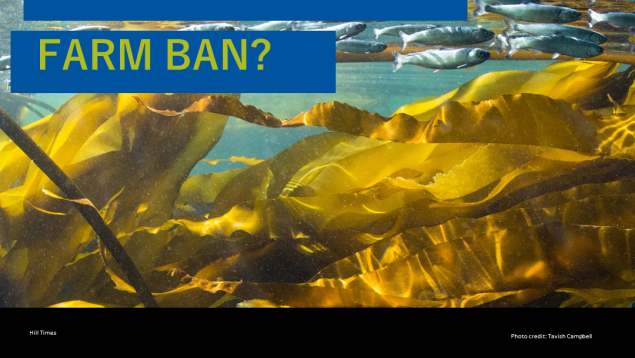
Opinion Editorial by Karen Wristen published in the Hill Times
The majority of First Nations, commercial fishers, and concerned British Columbians heaved a sigh of relief when Fisheries Minister Diane Lebouthillier said Canada would “ban” open net-pen feedlots of Atlantic salmon in British Columbia. After fighting to protect wild salmon for thirty-years, we may have finally achieved something here. It may not happen as quickly as we’d like to see given the perilous state of wild salmon, but we must applaud the politicians who have taken this brave step, and we must acknowledge the support that workers will need during this transition.
But this initial relief comes with urgent, pressing, questions. How will the ban be given the force of law? And, more importantly, until then, how will endangered wild Pacific salmon be protected from the plume of pollution, parasites, and pathogens spewing from the open net-pen feedlots staining coastal British Columbia?
Without being given legal force through legislation or regulations, the promised ban remains little more than another political promise vulnerable to ever-changing political winds. Our praise for that promise is coupled with healthy skepticism: the same folks now promising a ban by 2029 previously promised a “transition from” open net-pen feedlots by 2025. With at least one federal election between now and 2029, it’s possible those now promising a ban will not be around when the ban is supposed to take effect.
A bigger mystery is how the Department of Fisheries and Oceans will protect wild salmon from polluting open net-pen feedlots for the next five years. The Minister also announced that licences will be issued for five years and promised “stricter” licence conditions and regulations, but provided no detail. Those licence conditions, and more importantly, their enforcement will fall to DFO.
It’s no secret that the public, and successive Ministers, have very different views than DFO bureaucrats on the harm open net-pen feedlots cause. DFO has consistently denied any connection between the pathogens and parasites flowing out of salmon farms and wild salmon health. For years, DFO has refused to incorporate conditions of licence that measure or address sources of harm despite repeated and insistent calls from conservation groups and First Nations to do so. DFO still allows the stocking of open net-pen feedlots with fish infected with piscine orthoreovirus (PRV) and has not reviewed the efficacy of its sea lice management measures.
Now, despite DFO’s denial, the Minister has recognized the harm, exercised her discretion, and applied the precautionary principle by promising to remove this harmful industry from BC. Her decision should be a fatal blow to DFO’s decades long mismanagement by suppression and denial. Instead, we have an unresolved contradiction: on one hand, open net-pen feedlots must be removed to protect wild Pacific salmon; while on the other hand, those harmful feedlots can be governed by the ineffective regulatory regime and regulated by the same people whose objectivity and efficacy has been called into question by Mr. Justice Cohen, Canada’s Chief Science Advisor, the Commissioner for the Environment and Sustainable Development, and Parliament’s Standing Committee on Fisheries and Oceans (FOPO).
Endangered wild Pacific salmon need decisive action such as the announced ban. They also need urgent change to how they are protected while we wait for that decision to take effect. Open net-pens in B.C. are being phased out because they threaten the survival of wild Pacific salmon. New licence conditions to address this threat should have already been collaboratively developed. Instead, they will be tacked on by DFO in five-year licences granted at the end of June. Rarely are conditions altered during the term of a licence, but that might be exactly what needs to happen to ensure we have any wild salmon left to protect when the promised ban takes effect.

